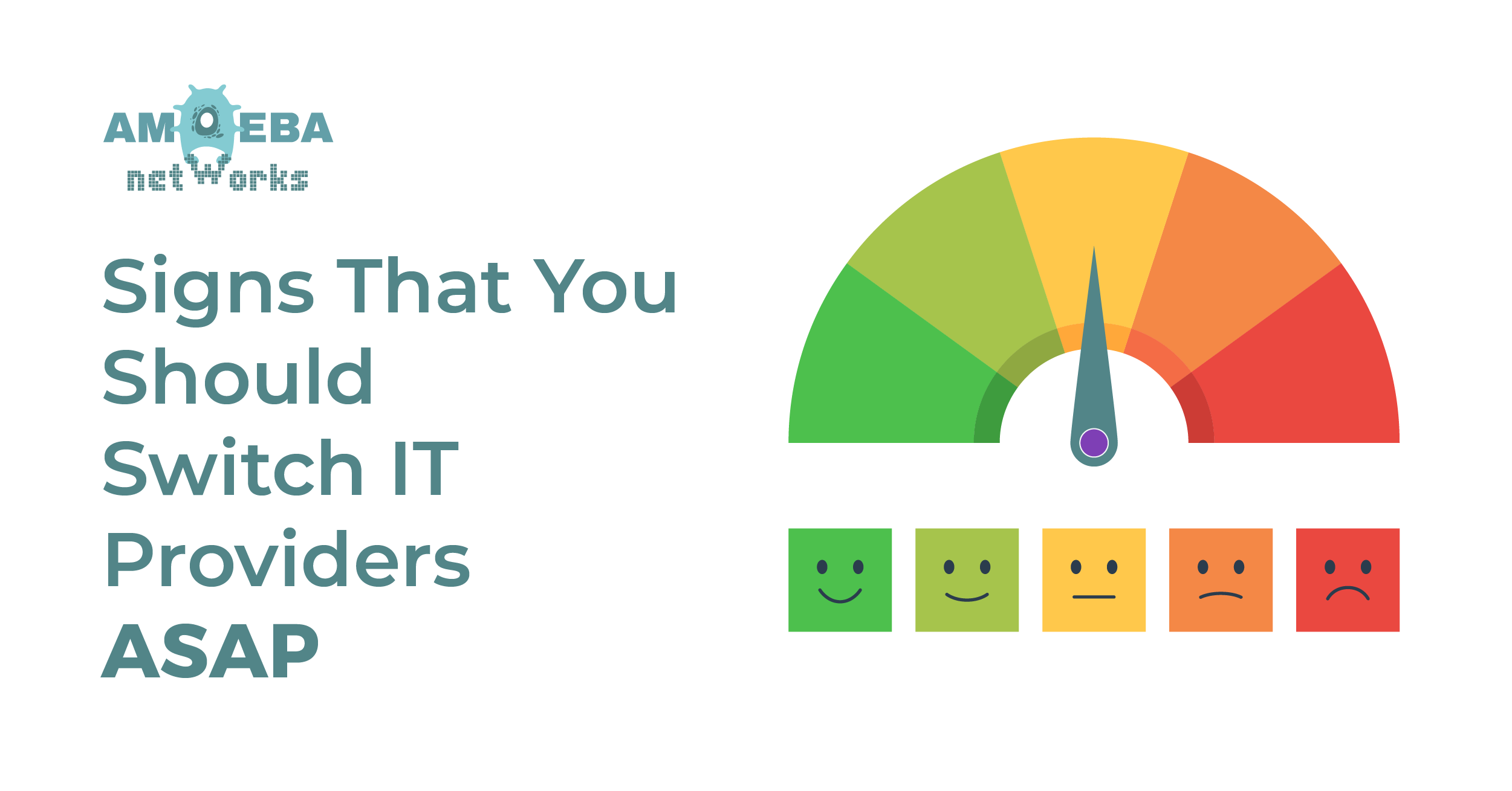
The main benefit of trusting a managed services provider, or an MSP, is to lower your overall technology costs. However, when you are unable to justify the monthly spend for your MSP, you must act quickly to avoid sinking more costs in a relationship that may not be worth it.
Take a look at the following seven signs you should switch IT providers as soon as possible.
1. Unresponsive IT
A slow response from your IT provider is one of the biggest symptoms of a vendor relationship that's likely costing you money in lost revenues, poor reputation, and low end-user or customer satisfaction. This is the first sign that a small business should switch IT providers as soon as possible because you are essentially getting bad service. Problems such as excessive downtime, staff complaints about unresolved issues and not having anyone to call for help are also signs of bad service from a provider.
In contrast, a good managed service provider (MSP) will consistently hit the mark on certain performance metrics for you. Take a look below for a high-level summary of two important metrics you should track when working with an MSP:
- Mean Time to Notify (MTTN): This metric measures the average amount of time passed before an MSP reports a service outage or incident to the customer.
- Mean Time to Repair (MTTR): MTTR will measure the average time your MSP takes to repair or resolve an issue for you.
2. Reactive Rather than Proactive IT
While the above metrics are important to take into account, they are also examples of the reactive aspect of a provider’s work and should not be the only metrics you are tracking. MSPs that are not operating strategically could fall into a “fire drill” rut, where they focus on only fixing problems as they arise. They go from one client’s issue to the next, rather than working to prevent them by understanding what the risks and potential issues are for each. Consider the following hypothetical cases.
Case 1: Provider 1 monitors cybersecurity breaches for company XYZ. A staff member from company XYZ downloads a file from an unknown source, and their device is infected with a virus. When this happens, the Provider 1 works to correct the breach and secure the infected computer.
Case 2: Provider 2 monitors and deploys corrective measures for company TUV, like the first provider. However, Provider 2 also implements managed email that has a built-in virus checker to scan all files coming into the mail servers and a quarterly training program for all TUV staff. In the training program, DEF educates on the importance of creating strong passwords and using 2-step verification processes. This provider also explains how to spot suspicious emails from cyber criminals that are looking to take advantage of system vulnerabilities or user error.
The approach Provider 2 is taking in case 2 above is more strategic and proactive. The responses in the above examples are oversimplified, however. The reality is that a major incident like a security breach can put a significant dent in your SMB’s bottom line and cause long-term damage to your brand’s reputation. For this reason, it is important for your service provider to do everything possible on your behalf to prevent major incidents from occurring in the first place.
If your IT provider is reactive rather than proactive, this is an indication of poor service as well. We suggest you consider switching providers ASAP. A good provider will instead employ proactive incidence management and use tools such as a quality assurance platform to monitor and sustain the overall systems integrity. They will also have a qualified team monitoring the platform constantly to increase their proactive incident resolution percentage (PIRP), another metric with which SMBs should measure their MSPs.
3. IT & Business Units Are Not Aligned
When it comes to investing in the company, senior managers at successful SMBs understand that it is important to align IT and business. But, how can you tell when there’s a lack of IT-business alignment when you’ve already hired an MSP? Take a look at the following symptoms of a technology service provider that is misaligned with business:
- The service provider never got to know what your business is truly about. In other words, they did not approach your company to know more about the business challenges you encounter or the objectives you’ve put in place for it.
- They do not enhance your business continuity. The outsourced professionals never asked whether you have a business continuity plan nor did they offer to collaborate with your internal teams to create one.
- There is no evident strategic direction. You haven’t ever been presented with a technology roadmap, and your service provider cannot express how the IT assets are having a meaningful impact on your business.
4. You Are Outgrowing Your Provider
If your SMB is growing, but your MSP is not, it may be time to switch providers. It’s possible that your provider is doing a stellar job of working proactively, and that they are managing MTTN and MTTR for your existing infrastructure fairly well. Due to this, their customer satisfaction (CSAT) score may be fairly high. However, if the provider is not prepared to scale with you, because they lack the equipment, people, expertise, and/or capabilities, you may have outgrown your favorite provider, and it’s time to move on.
5. Cybersecurity Concerns
More than half of all cyberattacks are committed against small-to-midsize businesses(SMBs), and 60 percent of them go out of business within six months of falling victim to a data breach or hack.
We all remember the massive attack on software company Kaseya, which targeted mainly MSPs. This attack served as a case of lessons learned for dozens of MSPs across the country, and there is guidance available released specifically for MSPs by the Cybersecurity & Infrastructure Security Agency.
If even after this recent massive attack on our security and infrastructure at a national level, your IT provider seems to not be taking the appropriate measures, it’s time to look for a new partner. You hired your MSP to safeguard your company’s and your customers’ data in the first place. If the MSP does not protect your company’s assets through a stringent security strategy, sooner or later you’ll have a problem on your hands. Knowing that a provider entrusted with such valuable information is not taking a potential security breach seriously can result in confidence lost.
6. You Lack Confidence in Your IT Provider
As a business leader, you have made it your mission to keep your customers’ trust intact. You know that when people lose confidence in a brand, it’s a hard blow for companies to recover from. So when you or your team members lose confidence in your MSP, it’s a huge red flag. Whatever the reason for the loss in confidence, whether they overpromise and don’t deliver on those promises, they make excuses and hide mistakes, or your bills become inconsistent or inflated, we recommend you don’t lose time in looking for a new partner.
7. Project Performance Has Suffered
When technology projects are well-managed, they have the potential to become profitable for any type of business. Poor technology project performance is a sign that your company may need to partner with a different MSP. Performance can suffer due to one of a myriad of reasons that arise when project management skills are lacking. If and when this happens, it’s best to cut your losses and switch providers ASAP.
Here are a few symptoms to look out for:
- Poor communication: There is no clear line of communication from the key players implementing the project that will provide project updates, inform on setbacks, and report successes.
- No monitoring and evaluation: Without time or progress tracking, digital projects can go out of scope, as well as take longer and more resources to implement.
- No accountability: Working for an extended period of time without receiving an explanation about delays and large scope changes.
Hire a Strategic Partner
The seven signs we shared in this article all boil down to the need for a strategic partner to work with you. As your company's strategic head, you will need to assess how the company resources are best allocated. This way, rather than a costly monthly expense, technology truly will become a sound investment for your SMB. If you are experiencing any of these disappointing circumstances, it's best to let go of the sunk cost and switch now.
Please contact us if you're ready to speak with an experienced MSP in New York City that can prepare, execute, and manage a proactive, strategic plan for your company’s technological implementations.




